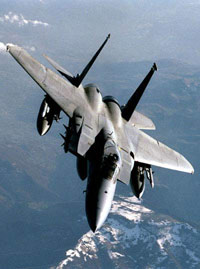
It didn't take long for the world to figure out the combat potential of airplanes. In 1911, only eight years after the Wright brothers got their creation off the ground, the U.S. military started dropping test bombs from airplanes. A few years later, World War I troops were battling it out in the sky with machine-gun-packing fighter planes.
Things moved pretty quickly from there. Only 60 years later, the early single-engine propeller planes had evolved into sleek, powerful fighter jets that could make sharp aerial turns at more than 600 miles per hour (970 kph).

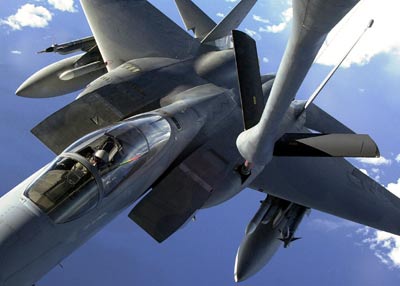
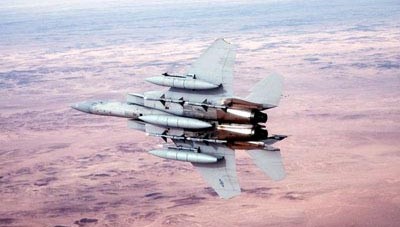
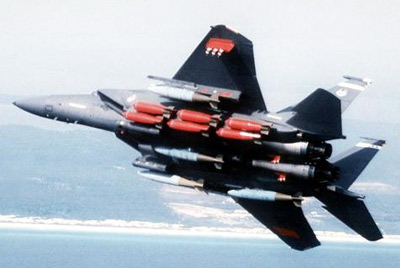
In the next section, we'll see how these two planes are put together and find out how they dive, climb and dodge so gracefully.
|
|
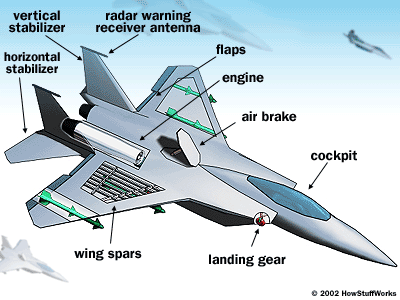 The main difference between an F-15 and an ordinary jet is how these elements are balanced. The F-15's twin engines (Pratt & Whitney F-100-PW-220s or 229s) have a very high thrust-to-weight ratio, meaning they are relatively light for the amount of thrust they generate (they can generate almost eight times their own weight in thrust).
The main difference between an F-15 and an ordinary jet is how these elements are balanced. The F-15's twin engines (Pratt & Whitney F-100-PW-220s or 229s) have a very high thrust-to-weight ratio, meaning they are relatively light for the amount of thrust they generate (they can generate almost eight times their own weight in thrust).
The plane body is relatively light, too, though it is extremely strong. The wing spars (the support structures inside the wings) are made of titanium, which is lighter and stronger than steel, and most of the skin is made of lightweight aluminum. According to the Air Force, each engine can generate between 25,000 and 29,000 pounds of force. The F-15C's normal weight is only 45,000 pounds, which means its thrust is actually greater than its weight! This lets it accelerate quickly, even while climbing in altitude.
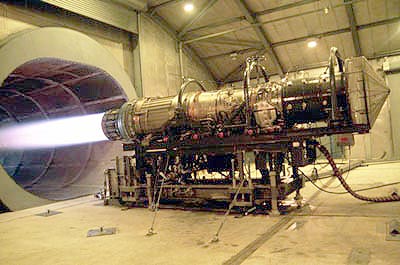
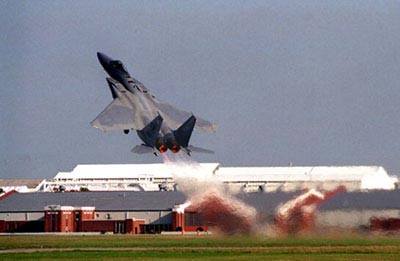
The engines are outfitted with afterburner nozzles, which can provide an extra kick of thrust when necessary. The afterburner simply injects fuel into the hot jet exhaust stream. It ignites, adding to the hot gases shooting out the back of the engine (see this Question of the Day for details on afterburners). At full force, the plane can get up to more than Mach 2.5 (approximately 1,854 mph / 2,984 kph).
The high engine power does come at a price -- poor fuel economy. Of course, the F-15 was designed with this limitation in mind. In order to extend its un-refueled range, it was built with large internal fuel tanks in the fuselage (the main body) and in the wings. It can also carry three external tanks, as well as a pair of aerodynamic form-fitting tanks under the wings that generate some lift of their own. Fully fueled, the F-15C can fly 3,450 miles (5,550 km), and the F-15E can fly 2,400 miles (3,860 km).
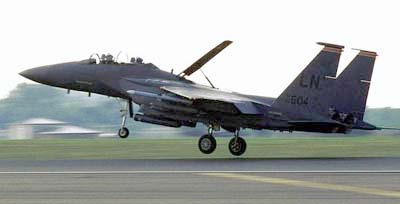 The other problem with the engines is that they wear out pretty quickly. This is to be expected, given the amount of work they do. Fortunately, they're very easy to replace -- an Air Force ground crew can do it in less than an hour!
The other problem with the engines is that they wear out pretty quickly. This is to be expected, given the amount of work they do. Fortunately, they're very easy to replace -- an Air Force ground crew can do it in less than an hour!
The F-15 doesn't just take off quickly, it stops quickly too. It has its own extendable air-brake, a hydraulically operated panel that dramatically increases the aircraft's drag to slow it down (just like a parachute).
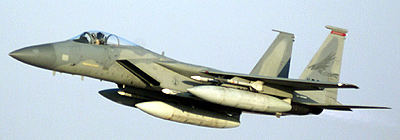
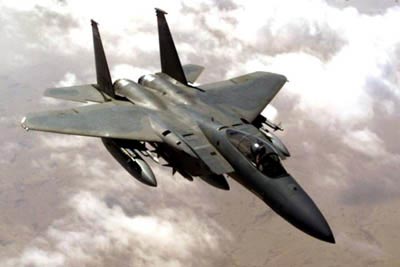 The plane is essentially a robot. It has a central computer, which is connected to an array of advanced sensors. Based on input from the inertial guidance system (which contains highly sensitive gyroscopic sensors) and the pilot, the computer activates hydraulic actuators to adjust the wings and rear stabilizers. The pilot doesn't actually fly the plane directly: He or she gives instructions and the computer decides how to carry them out. The computer is constantly making flight adjustments on its own to improve flight performance -- the computer artificially creates a relatively smooth ride. The F-15 computer can make necessary adjustments in milliseconds, about a hundred times faster than a human being.
The plane is essentially a robot. It has a central computer, which is connected to an array of advanced sensors. Based on input from the inertial guidance system (which contains highly sensitive gyroscopic sensors) and the pilot, the computer activates hydraulic actuators to adjust the wings and rear stabilizers. The pilot doesn't actually fly the plane directly: He or she gives instructions and the computer decides how to carry them out. The computer is constantly making flight adjustments on its own to improve flight performance -- the computer artificially creates a relatively smooth ride. The F-15 computer can make necessary adjustments in milliseconds, about a hundred times faster than a human being.
| If You're Shopping...
According to the Air Force, one F-15 Strike Eagle goes for $31.1 million. The F-15D is a relative steal at only $29.9 million, and a first generation plane will only cost you $27.9 million. While this sounds like a lot to the average person, it's actually a pretty good deal in the military world. Airmen say it's a small price to pay for the F-15's extraordinary performance level. |
The F-15 Strike Eagle has additional scanning equipment called the low-altitude navigation and targeting infrared for night (LANTIRN) system. The LANTIRN system is housed in two pods mounted to the bottom of the plane, near the engine inlets.
The navigation pod holds another radar unit that is optimized to map the ground terrain, and a forward-looking-infrared (FLIR) night vision scanner that picks up the infrared heat energy from surrounding objects. Together, these sensors generate a detailed image of the ground below, allowing the pilot or computer to fly in total darkness.
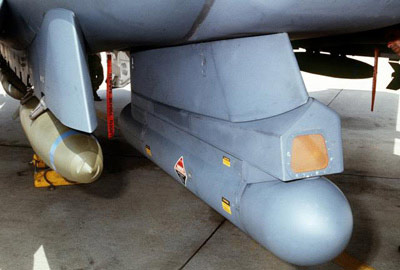 The targeting pod houses a powerful laser and another FLIR scanner, mounted to a swiveling turret. The laser works as a range-finder, calculating the distance to targets based on how long it takes a laser beam to bounce off of them, and also as a target designator, marking targets for laser-guided missiles. The targeting system is designed to pick out ground targets, but it can also be used in air-to-air combat.
The targeting pod houses a powerful laser and another FLIR scanner, mounted to a swiveling turret. The laser works as a range-finder, calculating the distance to targets based on how long it takes a laser beam to bounce off of them, and also as a target designator, marking targets for laser-guided missiles. The targeting system is designed to pick out ground targets, but it can also be used in air-to-air combat.
The central computer processes data from the radar and the LANTIRN system and presents targeting and navigation information to the crew. In the next section, we'll look inside the cockpit to see how the crew accesses this information, flies the plane and targets the enemy.
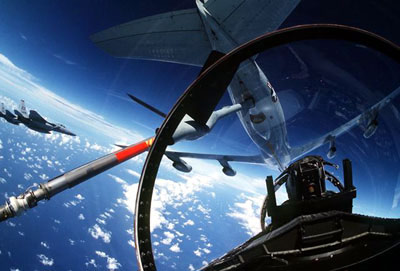
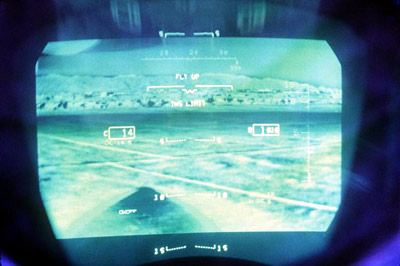
The controls are designed with the hands-on throttle and stick (HOTAS) system. In the HOTAS system, every switch and button on the controls has a different shape and texture. This way, the pilot can control all the major aspects of the plane without ever looking down into the cockpit.
The WSO, by contrast, doesn't spend much time looking outside the cockpit. He or she monitors radar, LANTIRN and flight data on four multi-function displays (MFD) -- cathode ray tube monitors surrounded by buttons (sort of like the display on an automatic teller machine). The WSO position has a full set of flight controls, but this is only a back-up provision -- normally, the WSO doesn't help fly the plane. Both the pilot and the WSO sit in high-tech ACES II ejection seats, which launch them clear of the plane in an emergency.
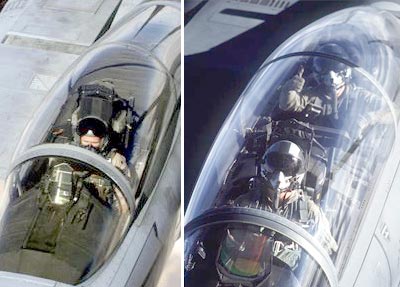
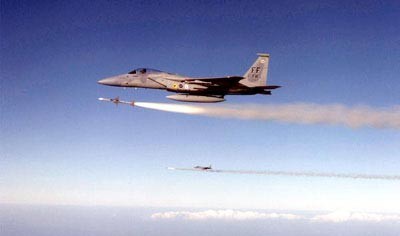
The Sparrow missile works on a similar principle, but it doesn't have its own radar transmitter. The pilot has to keep the plane's transmitter aimed at the target, to "paint" it for the missile.
The sidewinder missile uses an infrared sensor to pick up on an enemy plane's hot engine exhaust. The flight controls simply steer the missile toward the hottest area in sight.
The F-15 also has a built-in machine gun, an M-61 20-mm 6-barrel cannon, mounted inside the starboard (right) wing. The gun has an efficient Gatling gun design that can fire about 6,000 rounds per minute. It never gets the chance, however, because its magazine only holds 940 rounds. It can empty its entire magazine in less than 10 seconds!
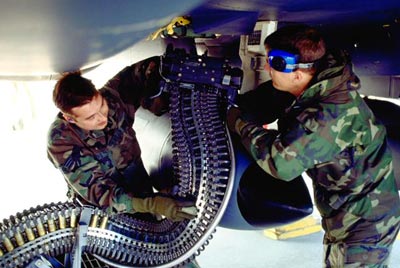
The F-15 Strike Eagle has all of these weapons, and it can also carry just about any air-to-ground missile in the Air Force arsenal. It often carries guided munitions, such as the GBU-15 bomb. All in all, it can carry approximately 23,000 pounds (10,430 kg) of ordnance.
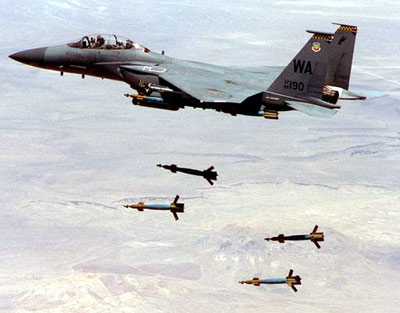 Both F-15 models also have a number of high-tech defenses. They have radar warning receivers, which detect enemy radar from ground stations, planes or guided missiles, and an advanced radar jammer to confuse these radar units. They also have a chaff dispenser, a device that shoots out a cloud of metal strips. Enemy radar picks up the chaff and temporarily loses its lock on the F-15.
Both F-15 models also have a number of high-tech defenses. They have radar warning receivers, which detect enemy radar from ground stations, planes or guided missiles, and an advanced radar jammer to confuse these radar units. They also have a chaff dispenser, a device that shoots out a cloud of metal strips. Enemy radar picks up the chaff and temporarily loses its lock on the F-15.
The F-15's combination of high maneuverability, sophisticated electronics and powerful weaponry have made it a hugely successful weapon in the United States arsenal (and a number of other countries' arsenals, as well). But now it's approaching the end of its run. Boeing and Lockheed Martin have already developed its replacement, the F-22 Raptor.
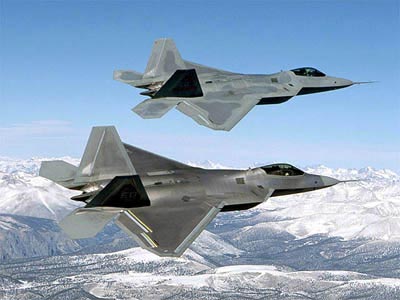 The Raptor takes everything on the F-15 to a whole new level, with much greater acceleration, maneuverability and computer power. It's also designed for stealth flying, just like the F-117 and B-2 bomber. When the F-22 enters service in 2005, the Air Force will phase out the F-15 Eagle. The F-15 Strike Eagle will keep flying for the foreseeable future.
The Raptor takes everything on the F-15 to a whole new level, with much greater acceleration, maneuverability and computer power. It's also designed for stealth flying, just like the F-117 and B-2 bomber. When the F-22 enters service in 2005, the Air Force will phase out the F-15 Eagle. The F-15 Strike Eagle will keep flying for the foreseeable future.
For much more information about the F15, the F-22 and other military aircraft, check out the links on the next page.